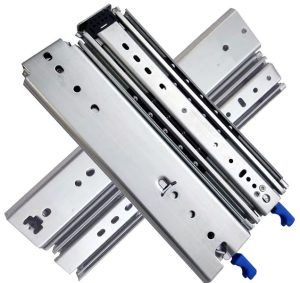
Regardless of the material from which they are made, all drawer slides fall into one of two categories: non-locking or locking. They are both used to facilitate the opening and closing of drawers. After mounting a pair of drawer slides to the bottom or sides of a drawer, you can pull the drawer open. Locking drawer slides, however, have a locking feature that distinguishes them from non-locking drawer slides.
What Are Non-Locking Drawer Slides?
Non-locking drawer slides are characterized by their inability to lock into place. They are the most common type of drawer slides. You can find them on dressers, chests of drawers, nightstands, end tables, desks and more. Some of them feature wheels on a set of tracks, whereas others feature ball bearings. Regardless, non-locking drawer slides can’t lock into place.
What Are Locking Drawer Slides?
Locking drawer slides, as you may have guessed, can be locked into place. You can typically lock them in either the opened or closed position. When locked into the opened position, you won’t be able to push the drawer slide closed. When locked into the closed position, you won’t be able to pull the drawer slide open.
Differences Between Non-Locking and Locking Drawer Slides
Both non-locking and locking drawer slides are used for the same purpose of facilitating the opening and closing of drawers, and you can find them in different styles, such as wheel-based and ball bearing-based. The difference is that locking drawer slides have a locking mechanism that, when engaged, will immobilize the drawers with which they are used.
Non-locking drawer slides are typically easier to install than their locking counterparts. They feature a simpler design with fewer parts. As a result, non-locking drawer slides are a popular choice for beginners.
Non-locking drawer slides often cost less than locking drawer slides as well. Since they don’t have a built-in locking mechanism, they cost less to produce. These cost-savings are often passed down to customers in the form of a lower price.
There are still reasons to choose locking drawer slides, one of which is convenience. They are more convenient than non-locking drawer slides, especially when used in the workplace. If you regularly retrieve items from a toolbox, for instance, you may want to lock the toolbox’s drawers open.
One of the biggest advantages of locking drawer slides is safety. Opened drawers can pose a safety hazard. If a drawer accidentally opens, you may bump into it, which can lead to bruises or fall-related injury. Locking drawer slides eliminate this concern by allowing you to lock them closed when you are finished using them.
